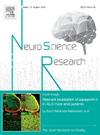Formyl peptide receptor 2 antagonist WRW4 ameliorates diabetes-induced cognitive decline in mice
IF 2.4
4区 医学
Q3 NEUROSCIENCES
引用次数: 0
Abstract
Cognitive impairment is a significant complication of diabetes. Although the detailed mechanism remains unclear, prolonged neuroinflammation mediated by microglia is recognized as a key contributor to neural dysfunction. Recent studies have shown that Formyl peptide receptor 1 (FPR1), a G protein-coupled chemoattractant receptor, plays a role in microglial activation and brain pathology. However, the involvement of FPR2, another isoform within the FPR family, in microglial activation and cognitive decline has not yet been explored. In this study, we observed an increased expression of FPR2 in microglia within the hippocampus of type 2 diabetes (db/db) mice. Furthermore, we demonstrated that intracerebroventricular administration of WRW4, a selective FPR2 antagonist, alleviates diabetes-related cognitive decline. Histological analysis revealed that WRW4 treatment mitigates morphological alteration and upregulation of a phagocytic marker (CD68) of the microglia in the hippocampus of db/db mice. These results indicate that FPR2 plays a critical role in inducing diabetes-related microglial phenotype. These findings highlight the therapeutic potential of FPR2 signal inhibition as a novel strategy to mitigate cognitive decline associated with diabetes.
甲酰基肽受体2拮抗剂WRW4改善糖尿病诱导的小鼠认知能力下降。
认知障碍是糖尿病的一个重要并发症。虽然详细的机制尚不清楚,但由小胶质细胞介导的长期神经炎症被认为是神经功能障碍的关键因素。近年来的研究表明,甲酰基肽受体1 (FPR1)是一种G蛋白偶联的化学引诱剂受体,在小胶质细胞的激活和脑病理中起着重要作用。然而,FPR家族中的另一种亚型FPR2在小胶质细胞激活和认知能力下降中的作用尚未被探索。在本研究中,我们观察到2型糖尿病小鼠海马内小胶质细胞中FPR2的表达增加(db/db)。此外,我们证明了脑室内给药WRW4(一种选择性FPR2拮抗剂)可以减轻糖尿病相关的认知能力下降。组织学分析显示,WRW4处理减轻了db/db小鼠海马小胶质细胞形态改变和吞噬标志物(CD68)的上调。这些结果表明,FPR2在诱导糖尿病相关的小胶质细胞表型中起关键作用。这些发现强调了FPR2信号抑制作为一种缓解糖尿病相关认知能力下降的新策略的治疗潜力。
本文章由计算机程序翻译,如有差异,请以英文原文为准。
求助全文
约1分钟内获得全文
求助全文
来源期刊

Neuroscience Research
医学-神经科学
CiteScore
5.60
自引率
3.40%
发文量
136
审稿时长
28 days
期刊介绍:
The international journal publishing original full-length research articles, short communications, technical notes, and reviews on all aspects of neuroscience
Neuroscience Research is an international journal for high quality articles in all branches of neuroscience, from the molecular to the behavioral levels. The journal is published in collaboration with the Japan Neuroscience Society and is open to all contributors in the world.
 求助内容:
求助内容: 应助结果提醒方式:
应助结果提醒方式:


